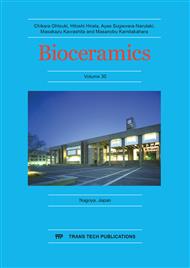[1]
Khan NA, Jhung SH. Synthesis of metal-organic frameworks (MOFs) with microwave or ultrasound: Rapid reaction, phase-selectivity, and size reduction. Coord Chem Rev 2015; 285:11-23.
DOI: 10.1016/j.ccr.2014.10.008
Google Scholar
[2]
Malgras V, Ji Q, Kamachi Y, Mori T, Shieh FK, Wu KC, Ariga K, Yamauchi Y. Templated synthesis for nanoarchitectured porous materials. Bull Chem Soc Jpn 2015; 88:1171-1200.
DOI: 10.1246/bcsj.20150143
Google Scholar
[3]
Vallet-Regi M, Balas F, Arcos D. mesoporous materials for drug delivery, Angew Chem Int Ed. 2007; 46: 7548-7558.
DOI: 10.1002/anie.200604488
Google Scholar
[4]
Fullriede H, Abendroth P, Ehlert N, Doll K, Schäske J, Winkel A, Stumpp SN, Stiesch M, Behrens P. pH-responsive release of chlorhexidine from modified nanoporous silica nanoparticles for dental applications, BioNanoMat. 2016; 17:59–72.
DOI: 10.1515/bnm-2016-0003
Google Scholar
[5]
Hea Q, Shi J. Mesoporous silica nanoparticle based nano drug delivery systems: synthesis, controlled drug release and delivery, pharmacokinetics and biocompatibility. J Mater Chem 2011; 21:5845-5855.
DOI: 10.1039/c0jm03851b
Google Scholar
[6]
Shibata S, Aoki K, Yano,T, Yamane M. Preparation of silica microspheres containing Ag nanoparticles. J Sol-Gel Sci. Technol. 1998; 11: 279-287.
Google Scholar
[7]
Tagaya M, Abe S, Motozuka S, Shiba K, Takemura T, Hayashi I, Sakaguchi Y, Surface-engineered mesoporous silica particles with luminescent, cytocompatible and targeting properties for cancer cell imaging, RSC Advances 2017;7:13643−13652.
DOI: 10.1039/c7ra00535k
Google Scholar
[8]
Gulati K, Maher S, Chandrasekaran S, Findlay DM, Losic D. Conversion of titania (TiO2) into conductive titanium (Ti) nanotube arrays for combined drug-delivery and electrical stimulation therapy. J Mater Chem B 2016; 4:371-375.
DOI: 10.1039/c5tb02108a
Google Scholar
[9]
Nakamura K, Nakanishi K, Bando Y, Hasebe A, Hyono A, Abe S, Shibata K, Yoshida Y, Iida J, Yawaka Y, Nano Biomedicine 2017;9:29-34.
Google Scholar
[10]
K. Nakanishi, S. Abe, S. Yamagata, Y. Yoshida, J. Iida, Key Eng. Mater. 2016;696:80-86.
Google Scholar
[11]
Kucukyilmaz E, Savas S. Evaluation of shear bond strength, penetration ability, microleakage and remineralisation capacity of glass-ionomer-based fissure sealants. Eur J Paediatr Dent. 2016;17: 17-23.
Google Scholar
[12]
Yonel N, Bikker FJ, Lagerweij MD, Kleverlaan CJ, Van Loveren C, Özen B, Çetiner S, Van Strijp AJ. Anti-erosive effects of fluoride and phytosphingosine: an in vitro study. Eur J Oral Sci. 2016; 124:396-402.
DOI: 10.1111/eos.12283
Google Scholar
[13]
K. Nakamura, S. Abe, H. Minamikawa, Y. Yawaka, Calcium charge and release of conventional glass-ionomer cement containing nano porous silica, Materials (in revision).
DOI: 10.3390/ma11081295
Google Scholar
[14]
Namba N, Yoshida Y, Nagaoka, N, Takashima, S, Matsuura-Yoshimoto, K , Maeda, H, Van Meerbeek, B, Suzuki, K, Takashiba, S, Dental Materials 2009;25:424-430.
DOI: 10.1016/j.dental.2008.08.012
Google Scholar
[15]
Gjorgievska E, Apostolska S, Dimkov A, Nicholson JW, Kaftandzieva A, Incorporation of antimicrobial agents can be used to enhance the antibacterial effect of endodontic sealers, Dental Materials 2013;29:E29-34.
DOI: 10.1016/j.dental.2012.10.002
Google Scholar
[16]
Lopez CB, Palleiro MMO, Gonzalez BS, and Vidal ES, Mynocycline induced hypersensitivity pneumonitis, Medicia Clinica 2007;128:79-79.
Google Scholar
[17]
Larsson DE, Hassan S, Larsson R, Oberg K, Granberg D, Combination analyses of anti-cancer drugs on human neuroendocrine tumor cell lines, Cancer Chemotherapy and Pharmacology 2009;65: 5-12.
DOI: 10.1007/s00280-009-0997-6
Google Scholar
[18]
Frantz SW, Haines KA, Azar CG, Ward JI, Homan SM, Roberts RB, Chlorhexidine gluconate (CHG) activity against clinical isolates of vancomycin-resistant Enterococcus faecium (VREF) and the effects of moisturizing agents on CHG residue accumulation on the skin, J. Hospital Infection 1997;37:157-164.
DOI: 10.1016/s0195-6701(97)90185-7
Google Scholar
[19]
Roldan S, Herrera D, Santa-Cruz I, O'Connor A, Gonzalez I, and Sanz M, Comparative effects of different chlorhexidine mouth-rinse formulations on volatile sulphur compounds and salivary bacterial counts, J. Clinical Periodontology 2004;31:1128-1134.
DOI: 10.1111/j.1600-051x.2004.00621.x
Google Scholar
[20]
Abe S, Seitoku E, Iwadera N, Hamba Y, Yamagata S, Akasaka T, Kusaka T, Inoue S, Yawaka Y, Iida J, Sano H, Yonezawa T, Yoshida Y, Estimation of biocompatibility of nano-sized ceramic particles with osteoblasts, osteosarcomas and hepatocytes by static and time-lapse observation, J. Biomedicaal Nanotechnology 2016;12:472-480.
DOI: 10.1166/jbn.2016.2190
Google Scholar
[21]
Bando Y, Nakanishi K, Abe S, Yamagata S, Yoshida Y, Iida J, Electric charge dependence of controlled dye-release behavior in glass ionomer cement containing nano-porous silica particles. J. Nanoscience and Nanotechnol. 2018;18:75–79.
DOI: 10.1166/jnn.2018.14618
Google Scholar
[22]
RK. Iler, The Chemistry of Slica, Wiley, New York (1979).
Google Scholar


